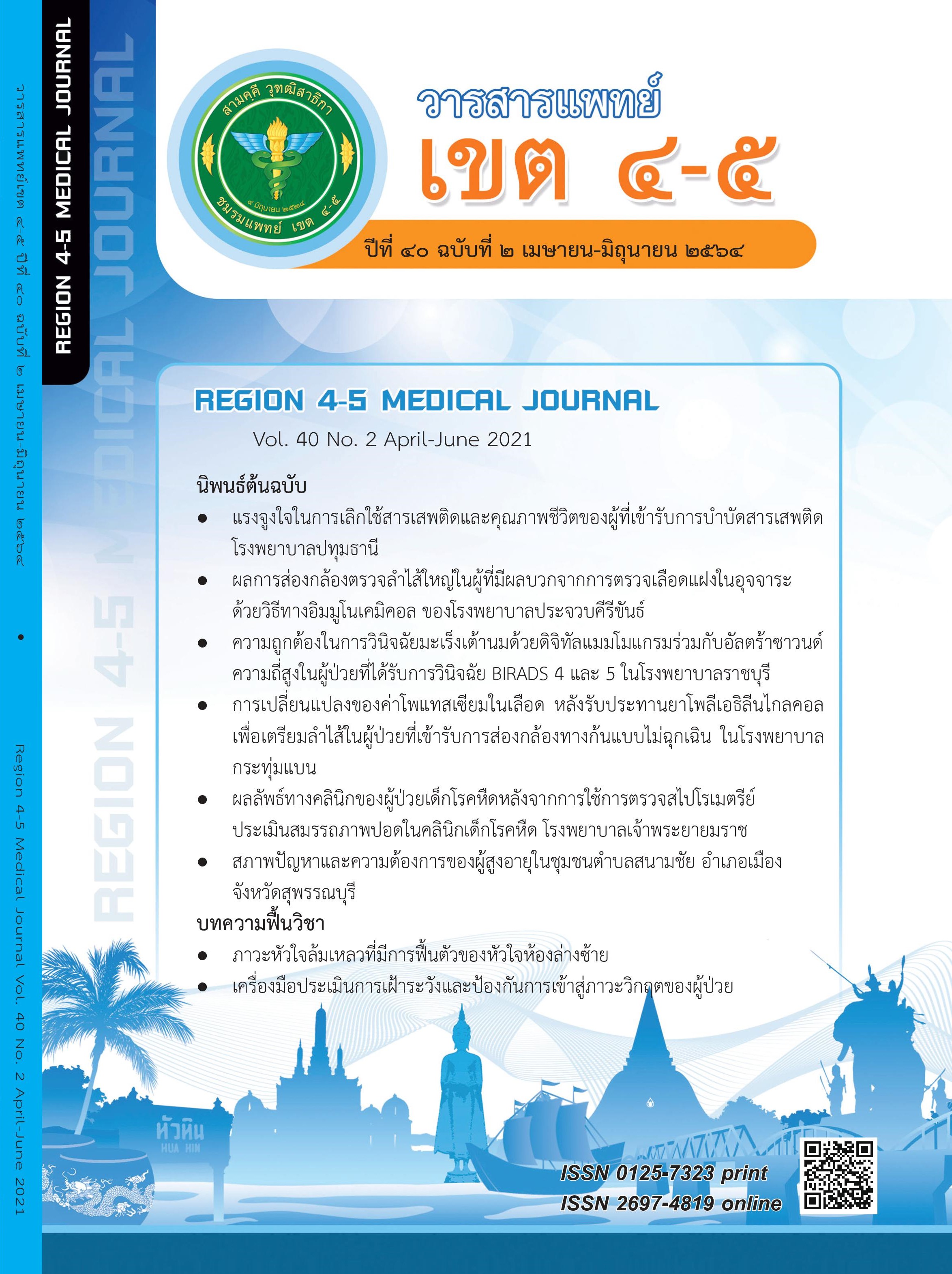ประสิทธิผลของโปรแกรมชะลอไตเสื่อมในผู้ป่วยโรคไตเรื้อรังระยะที่ 3 ของคลินิกโรคไตเรื้อรัง โรงพยาบาลอู่ทอง จังหวัดสุพรรณบุรี
คำสำคัญ:
โปรแกรมชะลอไตเสื่อม, ทีมสหวิชาชีพ, คลินิกโรคไตเรื้อรัง, โรคไตเรื้อรังระยะที่ 3บทคัดย่อ
วัตถุประสงค์: เพื่อศึกษาผลของโปรแกรมการชะลอไตเสื่อมแบบสหวิชาชีพในกลุ่มผู้ป่วยโรคไตระยะที่ 3 ในคลินิกโรคไตเรื้อรังที่ถูกจัดตั้งขึ้นใหม่ในปี 2558
วิธีการศึกษา: เป็นการศึกษาแบบ two-group pretest–posttest design เป็นเวลา 2 ปี ใช้สถิติ t-test โดยมีกลุ่มทดลองเป็นผู้ป่วยในคลินิกโรคไตเรื้อรังที่ถูกจัดตั้งขึ้นใหม่ในปี 2558 ได้รับการรักษาด้วยโปรแกรมการชะลอไตเสื่อมแบบสหวิชาชีพ มีกลุ่มควบคุม คือ ผู้ป่วยในคลินิกโรคเรื้อรังเดิมได้รับการรักษาตามมาตรฐานแบบเดิม
ผลการศึกษา: จกลุ่มผู้ป่วยในคลินิกโรคไตเรื้อรังสามารถชะลอไตเสื่อมได้จริง โดยมีค่าอัตรากรองไตก่อนศึกษาและหลังศึกษาไม่แตกต่างกันที่ 43.02 ± 6.88 มิลลิลิตร/นาที/1.73 เมตร2 และ 43.29 ± 10.47 มิลลิลิตร/นาที/1.73 เมตร2 ตามลำดับ ซึ่งหากเปรียบเทียบระดับค่ากรองไตที่ลดลง ในปีที่ 2 พบว่า คลินิกโรคเรื้อรัง (control) มีค่า -3.61 ± 7.52 มิลลิลิตร/นาที/1.73 เมตร2 และในคลินิกโรคไตเรื้อรังมีค่า -0.14 ± 7.42 มิลลิลิตร/นาที/1.73 เมตร2 โดยระดับค่ากรองไตที่ลดลงในปีที่ 2 ของคลินิกโรคไตเรื้อรังลดลงน้อยกว่า อย่างมีนัยสำคัญทางสถิติที่ p < .001 พบว่าร้อยละของผู้ป่วยที่ชะลอไตเสื่อมได้ผล (อัตราการกรองไตลดลง < 5 มิลลิลิตร/นาที/1.73 เมตร2 ในแต่ละปี) ของคลินิกโรคไตเรื้อรังมีแนวโน้มดีกว่า คลินิกโรคเรื้อรังชัดเจน คือ ร้อยละ 77.4 (155 ราย) และร้อยละ 81.9 (145 ราย) ในปีที่ 1 และ 2 ตามลำดับ เปรียบเทียบกับร้อยละ 76.3 (155 ราย) และ ร้อยละ 57.1 (116 ราย) ในปีที่ 1 และ 2 ของคลินิกโรคเรื้อรังตามลำดับ
สรุป: การจัดตั้งคลินิกโรคไตเรื้อรังเพื่อดูแลผู้ป่วยโรคไตเรื้อรัง โดยแพทย์ พยาบาล และทีมสหวิชาชีพ สามารถให้ความรู้ต่างๆ เพื่อสร้างความรู้คิด (cognitive) และพฤติกรรมสุขภาพที่ดี (behavior healthcare) จนเป็นความรู้ในการดูแลตนเอง (self-care) และการควบคุมตัวเอง (self-control) ทำให้ผู้ป่วยในคลินิกโรคไตเรื้อรังเข้าสู่กระบวนการชะลอไตเสื่อมได้อย่างมีประสิทธิภาพ
เอกสารอ้างอิง
2. บัญชา สถิระพจน์. Cardiovascular Risks and Treatment in Patients with Chronic Kidney Disease. เวชศาสตร์แพทย์ทหารบก. 2009; 62(1): 43-52.
3. Keith DS, Nichols GA, Gullion CM, et al. Longitudinal follow-up and outcomes among a population with chronic kidney disease in a large managed care organization. Arch Inter med. 2004; 164(6): 659-63. doi: 10.1001/archinte.164.6.659.
4. National Kidney Foundation. K/DOGI clinical Practice Guideline for chronic kidney disease evaluation, classification and stratification. Am J kidney Dis. 2002; 39(2 suppl 1): s1-246.
5. Kidney disease: Improving global outcomes (KDIGO) CKD work group. KDIGO 2012 clinical practice guideline for the evaluation and management of chronic kidney disease. Kidney Int Suppl. 2013; 3: 1-150.
6. สมาคมโรคไต. คำแนะนำสำหรับการดูแลผู้ป่วยโรคไตเรื้อรังปี 2558 [อินเทอร์เน็ต]. กรุงเทพฯ: สมาคมโรคไตแห่งประเทศไทย; 2558
7. Teerayuth J , Atiporn I , Krit P , et al. Effectiveness of Integrated Care on Delaying Progression of stage 3-4 Chronic Kidney Disease in Rural Communities of Thailand (ESCORT study): a cluster randomized controlled trial. BMC Nephrol. 2017; 18(1): 83.
8. Johons TS, Yee J, Smith-Jules T, et al. Interdisciplinary care clinics in chronic kidney disease. BMC Nephrology. 2015; 16: 161.
9. Chen YR, Yang Y, Wang SC, et al. Multidisciplinary care improves clinical outcome and reduces medical costs for pre-end-stage renal disease in Taiwan. Nephrology. 2014; 19(11): 699–707.
10. Gansevoort RT, Matsushita K, Van der velde M, et al. Lower estimated glomerular filtration rate and higher albuminuria are associated with mortality and end-stage renal disease. A collaborative meta-analysis of kidney disease population cohorts. Kidney Int. 2011; 80: 93-104.
11. ปุณญณิน เขื่อนเพ็ชร์, รุ้งลาวัลย์ กาวิละ, มนัชยา มรรคอนันตโชติ. ผลการดูแลสุขภาพแบบผสมผสานต่อผลลัพธ์ทางคลินิกในผู้ป่วยที่มีภาวะไตเสื่อมระดับ 3. เชียงรายเวชสาร. 2562; 11(2): 93-9.
12. Beavis J, Sobey B, Holt S. Individual versus group chronic kidney disease education [monograph on the Internet]. Maryland: Royal Melbourne Hospital Nephrology Parkville Australia; 2020
13. สมาคมโรคไตแห่งประเทศไทยและสำนักงานหลักประกันสุขภาพแห่งชาติ. คู่มือการจัดการดูแลผู้ป่วยโรคไตเรื้อรังระยะเริ่มต้น. กรุงเทพฯ: ยูเนียนอุลตร้าไวโอเร็ต; 2555.
14. อรรถสิทธิ์ ศรีสุบัติ, ธีรยุทธ เจียมจริยาภรณ์, เมธี จันทร์พิทักษ์กุล, วินัย ลีสมิทธิ์, วัชรพงศ์ วิศาลศักดิ์, สุชัญญา พรหมนิ่ม, และคณะ. ต้นทุน-ประสิทธิผลของการดูแลผู้ป่วยโรคไตเรื้อรังระยะ3 และ 4 ด้วยวิธีแบบผสมผสานเปรียบเทียบกับวิธีมาตรฐานในชุมชนชนบท. วารสารกรมการแพทย์. 2560; 6: 54-63.
15. วัชราภรณ์ กุลวงศ์, สังคม ศุภรัตนกุล, พัชราภรณ์ ไชยศรี. ความรู้และพฤติกรรมการใช้ยาต้านการอักเสบชนิดไม่ใช่สเตียรอยด์ของผู้สูงอายุในอําเภอทุ่งฝน จังหวัดอุดรธานี. วารสารการแพทย์โรงพยาบาลอุดรธานี. 2561; 2: 99.
ดาวน์โหลด
เผยแพร่แล้ว
รูปแบบการอ้างอิง
ฉบับ
ประเภทบทความ
สัญญาอนุญาต
ลิขสิทธิ์บทความเป็นของผู้เขียนบทความ แต่หากผลงานของท่านได้รับการพิจารณาตีพิมพ์ลงวารสารแพทย์เขต 4-5 จะคงไว้ซึ่งสิทธิ์ในการตีพิมพ์ครั้งแรกด้วยเหตุที่บทความจะปรากฎในวารสารที่เข้าถึงได้ จึงอนุญาตให้นำบทความในวารสารไปใช้ประโยชน์ได้ในเชิงวิชาการโดยจำเป็นต้องมีการอ้างอิงถึงชื่อวารสารอย่างถูกต้อง แต่ไม่อนุญาตให้นำไปใช้ในเชิงพาณิชย์




